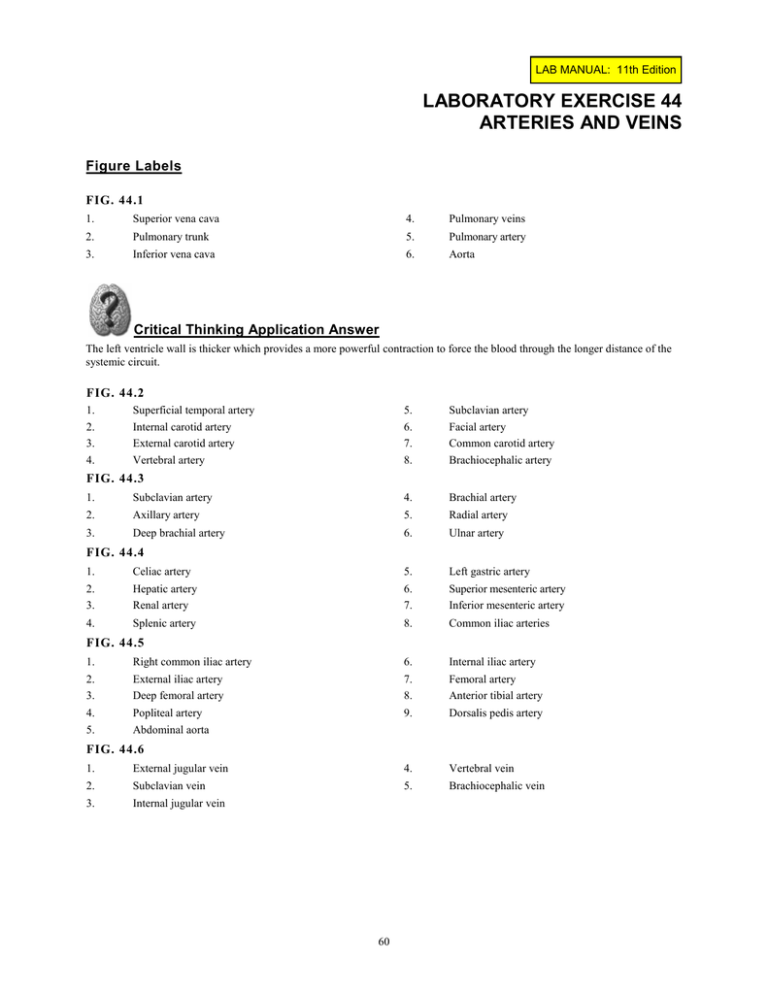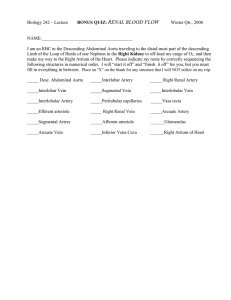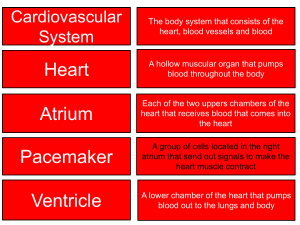laboratory exercise 44 arteries and veins
advertisement

LAB MANUAL: 11th Edition LABORATORY EXERCISE 44 ARTERIES AND VEINS Figure Labels FIG. 44.1 1. Superior vena cava 4. Pulmonary veins 2. Pulmonary trunk 5. Pulmonary artery 3. Inferior vena cava 6. Aorta Critical Thinking Application Answer The left ventricle wall is thicker which provides a more powerful contraction to force the blood through the longer distance of the systemic circuit. FIG. 44.2 1. 2. 3. 4. Superficial temporal artery Internal carotid artery External carotid artery Vertebral artery 5. 6. 7. 8. Subclavian artery Facial artery Common carotid artery Brachiocephalic artery FIG. 44.3 1. Subclavian artery 4. Brachial artery 2. Axillary artery 5. Radial artery 3. Deep brachial artery 6. Ulnar artery FIG. 44.4 1. Celiac artery 5. Left gastric artery 2. 3. Hepatic artery Renal artery 6. 7. Superior mesenteric artery Inferior mesenteric artery 4. Splenic artery 8. Common iliac arteries FIG. 44.5 1. Right common iliac artery 6. Internal iliac artery 2. 3. External iliac artery Deep femoral artery 7. 8. Femoral artery Anterior tibial artery 4. Popliteal artery 9. Dorsalis pedis artery 5. Abdominal aorta FIG. 44.6 1. External jugular vein 4. Vertebral vein 2. Subclavian vein 5. Brachiocephalic vein 3. Internal jugular vein 60 LAB MANUAL: 11th Edition FIG. 44.7 1. 2. 3. 4. Internal jugular vein Axillary vein Cephalic vein External jugular vein 5. 6. 7. 8. Brachiocephalic veins Subclavian vein Superior vena cava Azygos vein FIG. 44.8 1. Subclavian vein 6. Brachial vein 2. 3. 4. Right brachiocephalic vein Axillary vein Cephalic vein 7. 8. 9. Median cubital vein (antecubital vein) Radial vein Ulnar vein 5. Basilic vein FIG. 44.9 1. Hepatic portal vein 4. Splenic vein 2. 3. Superior mesenteric vein Gastric vein (right) 5. Inferior mesenteric vein FIG. 44.10 1. Common iliac vein 5. Femoral vein 2. 3. 4. External iliac vein Inferior vena cava Internal iliac vein 6. 7. 8. Great saphenous vein Popliteal vein Anterior tibial vein Laboratory Report Answers PART A 1. d 7. k 2. j 8. h 3. b 9. e 4. a 10. f 5. 6. g c 11. 12. l i PART B 1. right subclavian artery 6. vertebral artery 2. aortic arch 7. facial artery 3. superior mesenteric artery 8. brachial artery 4. inferior mesenteric artery 9. external iliac artery 5. right common carotic artery 10. left and right pulmonary arteries 61 LAB MANUAL: 11th Edition PART C 1. a 5. h 2. b 6. c 3. d 7. g 4. e 8. f PART D 1. right brachiocephalic vein 6. femoral vein 2. popliteal vein 7. hepatic portal vein 3. common iliace vein 8. pulmonary veins 4. basilic vein 9. renal vein 5. anterior tibial vein PART E (figure 44.11) 1. Common carotid artery 9. Subclavian vein 2. Brachiocephalic vein 10. Pulmonary vein 3. Superior vena cava 11. Inferior vena cava 4. Femoral vein 12. Aorta 5. Great saphenous vein 13. Common iliac vein 6. Internal jugular vein 14. Common iliace artery 7. External jugular vein 15. Femoral artery 8. Subclavian artery 62 LAB MANUAL: 11th Edition LABORATORY EXERCISE 45 CAT DISSECTION: CARDIOVASCULAR SYSTEM Laboratory Report Answers PART A 1. The parietal pericardium forms a relatively thick, tough sac that encloses the heart. It is attached to the large blood vessels at the base of the heart and to the diaphragm. 2. The walls of the atria are much thinner than those of the ventricles. The wall of the left ventricle is much thicker than that of the right ventricle. Wall thickness is related to the force of its contraction and the amount of pressure it imparts to the blood inside a heart chamber. The left ventricle has the thickest wall, contracts with the greatest force, and creates the greatest amount of blood pressure in the heart chambers. The left ventricle is the pump for the systemic circuit. 3. 4. 5. In the human, the right common carotid artery branches from the brachiocephalic artery, whereas the left common carotid artery comes directly from the aortic arch. In the cat, both common carotid arteries branch from the brachiocephalic artery. In the human, the aorta divides to form the two common iliac arteries, which in turn give rise to external and internal iliac arteries. In the cat, the aorta divides to form the external iliac arteries, and the internal iliac arteries branch from the aorta independently. PART B 1. In the human, the brachiocephalic vein is formed by the union of the internal jugular and the subclavian vein on each side. In the cat, the brachiocephalic vein is formed by the union of the external jugular and the subclavian vein on each side. 2. In the human, the internal jugular vein is somewhat larger than the external jugular vein. In the cat, the external jugular vein is larger. 3. Answers will vary. 63



